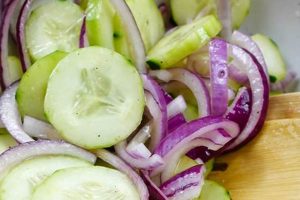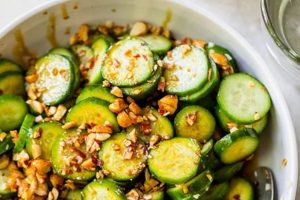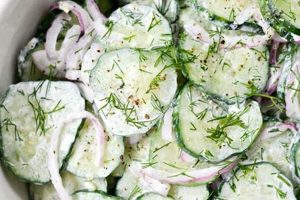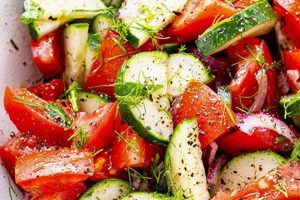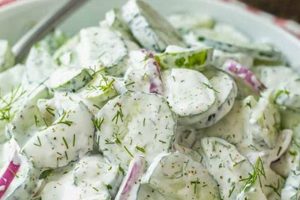Refreshing and light, cucumber salads offer a crisp counterpoint to heavier dishes. These salads typically feature thinly sliced cucumbers as the central ingredient, often combined with minimal additions like vinegar, onions, and herbs. A classic example includes thinly sliced cucumbers tossed with rice vinegar, sugar, and a sprinkle of sesame seeds.
Such salads provide a hydrating, low-calorie option, rich in vitamins and minerals. Their simplicity makes them incredibly versatile, adaptable to various cuisines and dietary needs. From quick side dishes to elegant appetizers, their refreshing nature has made them a culinary staple across cultures for generations. The straightforward preparation also contributes to their enduring popularity.
The following sections will explore a variety of approaches to these refreshing salads, from basic vinegar-based dressings to creamy variations, offering diverse flavor profiles and textures.
Tips for Exceptional Cucumber Salads
Elevating a cucumber salad from simple to extraordinary involves attention to detail and a few key techniques. The following tips offer guidance for achieving optimal flavor and texture.
Tip 1: Salt and Drain Excess Moisture: Salting sliced cucumbers draws out excess water, preventing a watery salad. After salting, allow the cucumbers to rest for 15-20 minutes, then gently pat dry with a paper towel.
Tip 2: Choose the Right Cucumber: English cucumbers, with their thinner skin and fewer seeds, are ideal. For a different flavor profile, Persian cucumbers offer a slightly sweeter taste.
Tip 3: Thinly and Evenly Slice Cucumbers: Uniformly thin slices ensure even flavor distribution and a pleasing texture. A mandoline slicer or sharp knife can achieve this.
Tip 4: Balance Flavors: Acidity plays a crucial role. Balance the sharpness of vinegar with a touch of sweetness or a pinch of salt.
Tip 5: Enhance with Fresh Herbs: Dill, mint, and parsley complement cucumbers beautifully. Chives or cilantro can add a unique twist.
Tip 6: Consider Textural Variety: Toasted nuts, sesame seeds, or thinly sliced red onion can add a welcome crunch.
Tip 7: Chill Before Serving: Chilling enhances the refreshing qualities of the salad. Allow at least 30 minutes for the flavors to meld.
By employing these techniques, one can create a cucumber salad that is not only refreshing but also a sophisticated and flavorful addition to any meal.
These tips provide a foundation for crafting exceptional cucumber salads. The following section will explore specific recipe variations.
1. Fresh Cucumbers
The foundation of any simple cucumber salad rests upon the quality of the cucumbers themselves. Freshness is paramount, directly impacting the flavor, texture, and overall appeal of the final dish. Using fresh cucumbers ensures a crisp, vibrant salad that highlights the vegetable’s delicate flavor profile.
- Selection
Selecting fresh cucumbers involves choosing firm, unblemished specimens with a vibrant green color. Avoid cucumbers with soft spots, wrinkles, or yellowing skin, as these indicate age and declining quality. Opting for smaller cucumbers often yields a more tender and less watery salad.
- Storage
Proper storage maintains freshness. Cucumbers are best stored in the refrigerator, ideally wrapped in a paper towel and placed in a plastic bag. This helps retain moisture and prevents them from drying out. Properly stored cucumbers can remain fresh for up to a week.
- Preparation
Preparation techniques influence the final result. Washing and drying cucumbers thoroughly before slicing is essential. For some recipes, salting and draining the sliced cucumbers removes excess moisture, preventing a watery salad and concentrating the flavor. Peeling is optional and depends on the cucumber variety and personal preference. English or Persian cucumbers often require less peeling due to their thinner skins.
- Flavor Impact
Fresh cucumbers possess a mild, refreshing flavor that pairs well with various ingredients. Their subtle sweetness and delicate cucumber aroma contribute to the overall balance of the salad, providing a clean, palate-cleansing element. The crisp texture of fresh cucumbers adds a satisfying crunch.
The emphasis on fresh cucumbers in simple salad recipes underscores the importance of quality ingredients. By prioritizing freshness in selection, storage, and preparation, one ensures a vibrant and flavorful salad that captures the essence of this versatile vegetable.
2. Thin Slicing
Thin slicing plays a crucial role in optimizing cucumber salad recipes. This technique maximizes surface area, allowing for greater absorption of flavors from dressings and other ingredients. The resulting delicate texture offers a pleasant mouthfeel, contrasting with potentially dense or chewy elements within the salad. Furthermore, thin slices contribute to a visually appealing presentation, showcasing the translucence and vibrant green hues of fresh cucumbers. A salad composed of thickly cut cucumbers, conversely, might limit flavor penetration and create a less refined culinary experience.
Consider a classic cucumber salad dressed with rice vinegar, sugar, and dill. Thinly sliced cucumbers readily absorb the sweet-tart dressing, infusing each bite with balanced flavor. Thicker slices, however, would create a barrier, leaving the interior of the cucumber untouched by the dressing, resulting in an uneven flavor profile. This principle applies equally to salads with more complex flavor combinations; thin slicing ensures every element harmonizes effectively.
Achieving consistently thin slices enhances both the aesthetic and gustatory aspects of the salad. Various tools, including mandolines, sharp knives, and even vegetable peelers, can facilitate this precision. Uniformity in slicing ensures even marinating and contributes to a visually appealing presentation. Ultimately, the practice of thin slicing underscores the importance of attention to detail in elevating a simple cucumber salad from basic to exceptional.
3. Balanced Seasoning
Balanced seasoning is paramount in simple cucumber salad recipes, where the subtle flavor of the cucumber necessitates a careful approach to complementary ingredients. Over-seasoning can easily mask the cucumber’s delicate taste, while under-seasoning results in a bland, uninspired dish. Achieving harmony among flavors elevates the salad from a simple side to a refreshing, palate-cleansing experience. The goal is to enhance, not overpower, the cucumber’s inherent qualities.
- Acidity
Acidity, often from vinegar or citrus juice, provides brightness and cuts through the cucumber’s mildness. Rice vinegar lends a subtle sweetness, while white wine vinegar offers a sharper tang. Lemon or lime juice contribute a citrusy freshness. The choice of acid depends on the desired flavor profile and other ingredients. For instance, a salad with dill and red onion benefits from the mildness of rice vinegar, while a spicier version with jalapeo might pair well with lime juice.
- Sweetness
A touch of sweetness balances the acidity and complements the cucumber’s inherent subtle sweetness. Granulated sugar, honey, or agave nectar are common choices. The amount of sweetener should be judicious, preventing the salad from becoming overly sweet. A small amount of sugar in a rice vinegar-based dressing balances the tartness, creating a harmonious flavor profile.
- Salt
Salt enhances the flavors of all ingredients, including the cucumber itself. It also helps draw out excess moisture from the cucumbers, preventing a watery salad. Kosher salt is preferred for its clean taste and ease of use. Salting the cucumbers separately before adding them to the salad allows for better moisture control and even distribution of flavor.
- Aromatics and Herbs
Fresh herbs and aromatics add complexity and depth. Dill, mint, and parsley are classic pairings with cucumber. Chives, cilantro, or tarragon offer unique alternatives. Minced garlic or shallots can add a savory note. Freshly ground black pepper adds a subtle spice. The choice of herbs and aromatics should complement the other ingredients and the overall flavor profile of the salad.
The interplay of these elements acidity, sweetness, salt, and aromatics determines the final character of the salad. Careful consideration of each component ensures a balanced and harmonious flavor profile that enhances the refreshing qualities of the cucumber. A well-seasoned simple cucumber salad offers a clean, vibrant taste that complements a wide range of dishes.
4. Subtle Sweetness
Subtle sweetness plays a crucial role in balancing the overall flavor profile of simple cucumber salad recipes. While cucumbers possess a naturally mild, refreshing taste, incorporating a touch of sweetness enhances their inherent flavors and complements other ingredients, particularly acidic components like vinegar. This delicate balance prevents the salad from becoming overly tart or bland, creating a more harmonious and palatable dish.
- Balancing Acidity
A small amount of sweetness tempers the sharpness of vinegar or citrus juice commonly used in cucumber salads. This interplay creates a balanced flavor profile, preventing the acidity from overpowering the delicate cucumber flavor. For instance, a rice vinegar dressing often includes a teaspoon or two of sugar to offset the vinegar’s tartness.
- Enhancing Cucumber Flavor
Subtle sweetness accentuates the cucumber’s natural flavors, bringing out their inherent mild sweetness and creating a more complex taste. This enhancement prevents the salad from tasting solely of the dressing, allowing the cucumber’s refreshing qualities to shine through. A pinch of sugar in a dill and cucumber salad can amplify the cucumber’s fresh taste.
- Creating Flavor Complexity
The addition of sweetness contributes to a more nuanced and layered flavor profile. This complexity elevates the salad beyond a simple combination of ingredients, creating a more sophisticated culinary experience. The subtle sweetness of a honey-lime dressing, for example, adds depth to a cucumber and avocado salad.
- Variety of Sweeteners
Different sweeteners offer unique flavor nuances. Granulated sugar provides a clean sweetness, while honey adds floral notes, and maple syrup contributes a hint of caramel. These variations allow for customization and creativity in recipe development. A cucumber salad with mint and feta might benefit from the delicate sweetness of honey, while a spicier version with chili flakes could pair well with the robust flavor of maple syrup.
The judicious use of subtle sweetness in simple cucumber salad recipes demonstrates a key principle of culinary balance. By carefully considering the interplay of sweet and acidic elements, one can elevate a simple salad to a sophisticated and refreshing dish that highlights the best qualities of fresh cucumbers. The choice of sweetener and its quantity contribute significantly to the overall flavor profile, offering endless possibilities for customization and culinary exploration.
5. Herbaceous Additions
Herbaceous additions are essential for elevating simple cucumber salad recipes beyond basic preparations. Fresh herbs introduce aromatic complexity and depth, complementing the cucumber’s delicate flavor while adding a vibrant, fresh element. The selection and application of herbs significantly influence the final character of the salad, transforming it from a simple side dish into a nuanced culinary experience.
- Classic Combinations
Dill, mint, and parsley are classic pairings with cucumber, offering familiar yet effective flavor enhancements. Dill’s subtly tangy, anise-like notes provide a refreshing counterpoint to the cucumber’s coolness. Mint contributes a bright, invigorating aroma and a subtle sweetness. Parsley offers a clean, slightly peppery taste that adds depth without overpowering the cucumber. These classic herbs, used individually or in combination, create a familiar and refreshing flavor profile.
- Exploring Beyond the Familiar
Beyond the classic choices, herbs like chives, tarragon, and cilantro provide unique flavor dimensions. Chives offer a delicate onion flavor, adding a subtle savory note. Tarragon contributes a distinctive anise-like flavor with hints of licorice. Cilantro provides a bright, citrusy aroma and a slightly pungent taste. Incorporating these less conventional herbs allows for greater culinary exploration and the creation of unique flavor profiles.
- Balancing Flavors and Textures
The choice of herbs should consider the other ingredients in the salad. For instance, a salad with a creamy dressing might benefit from the bolder flavor of cilantro, while a lighter vinaigrette might pair better with the delicate notes of dill. The texture of the herbs also plays a role. Finely chopped herbs integrate seamlessly, while whole leaves or sprigs provide visual appeal and bursts of flavor.
- Freshness and Quality
Using fresh, high-quality herbs is crucial for optimal flavor. Dried herbs lack the vibrancy and intensity of fresh herbs and should be avoided whenever possible. Proper storage, such as wrapping fresh herbs in a damp paper towel and storing them in the refrigerator, maintains their quality and extends their shelf life. Adding herbs just before serving preserves their fresh flavor and aroma.
The strategic use of herbaceous additions elevates simple cucumber salad recipes by introducing layers of flavor and aroma. Careful consideration of herb choices, their complementary nature with other ingredients, and their overall impact on the salad’s flavor profile are essential for achieving a balanced and refreshing culinary creation. Fresh, high-quality herbs are key to maximizing the impact of these herbaceous additions, transforming a simple cucumber salad into a vibrant and flavorful dish.
6. Minimalist Approach
A minimalist approach defines the essence of simple cucumber salad recipes. It emphasizes the inherent freshness and delicate flavor of the cucumber itself, allowing it to shine without being masked by complex or heavy additions. This approach prioritizes quality ingredients and straightforward techniques, resulting in a refreshing, palate-cleansing dish that embodies culinary restraint. The minimalist philosophy centers on enhancing, not obscuring, the cucumber’s natural characteristics. A classic example is a thinly sliced cucumber salad dressed simply with rice vinegar, a touch of sugar, and fresh dill. This uncomplicated combination allows the cucumber’s crisp texture and subtle sweetness to take center stage.
The minimalist approach extends beyond ingredient selection to encompass preparation methods. Thinly slicing, rather than elaborate chopping or dicing, preserves the cucumber’s structural integrity and allows for even flavor absorption. Avoiding lengthy marinades or complex cooking processes further underscores this minimalist philosophy. The focus remains on preserving the cucumber’s fresh, crisp texture and clean taste. Salting the cucumber slices and allowing them to drain before dressing exemplifies this principle, removing excess moisture without introducing additional flavors. This restraint results in a salad that is both light and flavorful, showcasing the cucumber’s inherent qualities.
Ultimately, the minimalist approach in cucumber salad recipes offers a compelling example of how simplicity can yield exceptional results. By prioritizing fresh, high-quality ingredients and employing straightforward techniques, one achieves a dish that is both refreshing and elegant. This approach underscores the importance of appreciating the inherent qualities of simple ingredients, allowing their natural flavors to shine through without unnecessary embellishment. The minimalist philosophy applied to cucumber salad epitomizes the concept of “less is more,” resulting in a culinary experience that is both satisfying and subtly complex.
7. Quick Preparation
Quick preparation is a defining characteristic of simple cucumber salad recipes, aligning with the emphasis on fresh, minimally processed ingredients and straightforward techniques. This speed and ease of assembly makes these salads an ideal choice for busy weeknight meals, impromptu gatherings, or as a last-minute addition to any menu. The minimal time investment required does not compromise the flavor or nutritional value, making quick preparation a significant advantage of these versatile salads.
- Minimal Processing
Simple cucumber salads typically require minimal processing of ingredients. Washing, slicing, and perhaps peeling the cucumbers constitute the bulk of the preparation. This streamlined approach reduces time spent on chopping, cooking, or other more elaborate techniques. For example, a basic cucumber and onion salad requires only slicing the vegetables and whisking together a simple vinaigrette, minimizing active preparation time.
- Few Ingredients
These salads often rely on a small number of fresh ingredients. Cucumbers, a few herbs, and a simple dressing are often all that is needed. This limited ingredient list streamlines the shopping process and reduces preparation time compared to recipes with extensive ingredient lists. A cucumber, dill, and red onion salad exemplifies this principle, showcasing how a few key components can create a flavorful dish with minimal effort.
- No Cooking Required
A significant advantage of simple cucumber salads is the absence of cooking. This eliminates the need for heating elements, preheating ovens, or monitoring cooking times, significantly reducing overall preparation time. Salads like a cucumber and mint salad with a lemon vinaigrette require no cooking whatsoever, allowing for rapid assembly and immediate serving.
- Adaptability and Improvisation
The simplicity of these salads lends itself to adaptability and improvisation. Ingredient substitutions are often seamless, accommodating readily available produce and pantry staples. This flexibility further simplifies the preparation process, removing the need for strict adherence to specific ingredients or measurements. A simple cucumber salad can easily be adapted to include other vegetables on hand, such as bell peppers or tomatoes, further streamlining the preparation process.
The quick preparation associated with simple cucumber salad recipes enhances their appeal as a convenient and healthy meal option. This efficiency, combined with the refreshing and flavorful nature of these salads, makes them a versatile addition to any culinary repertoire. The minimal time investment required allows for more time to savor the meal itself or attend to other aspects of meal preparation, making these salads a practical and enjoyable choice for a variety of occasions.
Frequently Asked Questions
This section addresses common inquiries regarding simple cucumber salad recipes, offering practical guidance and clarifying potential uncertainties.
Question 1: How can excess moisture be prevented in cucumber salads?
Salting sliced cucumbers draws out excess water. After salting, allow the cucumbers to rest for approximately 15-20 minutes, then gently pat them dry with a paper towel or clean cloth. This process prevents a watery salad and concentrates the cucumber flavor.
Question 2: What type of cucumber is best suited for these salads?
English cucumbers, known for their thin skin and fewer seeds, are generally preferred. However, Persian cucumbers offer a slightly sweeter alternative. The choice depends on individual preference and the desired flavor profile.
Question 3: What are effective methods for achieving thin cucumber slices?
A mandoline slicer provides consistent, thin slices. Alternatively, a sharp knife can be used, ensuring careful and even cutting. For a rustic look, a vegetable peeler can create thin ribbons of cucumber.
Question 4: How can one balance the flavors in a cucumber salad?
Balancing acidity with a touch of sweetness is key. A small amount of sugar or honey can offset the sharpness of vinegar. Additionally, a pinch of salt enhances all flavors and helps draw out moisture.
Question 5: Which herbs complement cucumber particularly well?
Dill, mint, and parsley are classic choices. Dill offers a subtly tangy flavor, mint provides a refreshing coolness, and parsley adds a clean, slightly peppery note. Other herbs like chives, cilantro, or tarragon can also provide interesting flavor variations.
Question 6: How long should cucumber salad be chilled before serving?
Chilling for at least 30 minutes allows the flavors to meld and enhances the refreshing qualities of the salad. However, extended chilling can sometimes diminish the crispness of the cucumbers.
Understanding these fundamental aspects of cucumber salad preparation ensures optimal results. Careful attention to detail, from ingredient selection to seasoning and chilling, contributes to a refreshing and flavorful dish.
The following section will offer a selection of specific recipes for exploration.
Simple Cucumber Salad Recipes
Simple cucumber salad recipes offer a refreshing and versatile culinary canvas. Exploration of key elementsfresh cucumbers, thin slicing, balanced seasoning, subtle sweetness, herbaceous additions, minimalist approach, and quick preparationreveals the potential for nuanced flavor within this seemingly simple dish. Attention to detail in each aspect, from ingredient selection to chilling time, elevates the final product beyond basic fare.
Culinary exploration within the realm of simple cucumber salads encourages appreciation for fresh, seasonal produce and the transformative power of balanced flavors. Continued experimentation with diverse ingredients and techniques promises further evolution of this classic dish, offering a refreshing counterpoint to more complex culinary endeavors.


